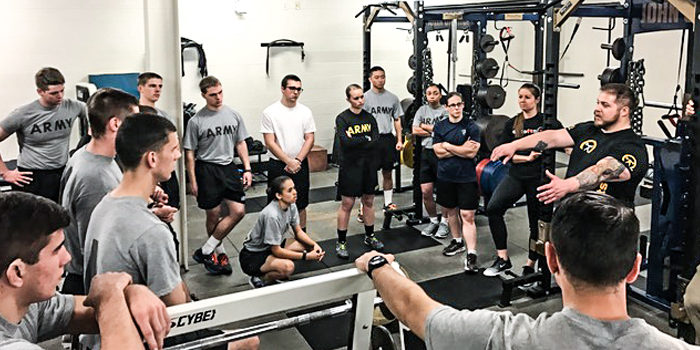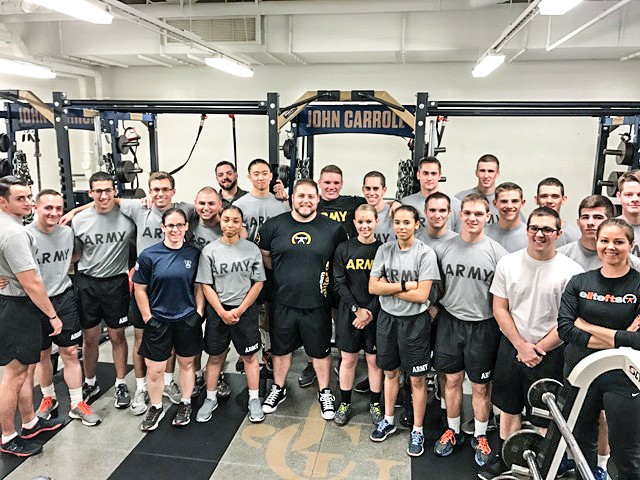
A few months ago, several members of Team elitefts visited my organization and gave us a brief presentation about powerlifting and nutrition for military personnel. Let me say that this was one of the best seminars I have attended in nearly 20 years of military service.
First, some information about me and my organization: I am currently the Senior Military Instructor for the John Carroll University Army ROTC Program. Participating in ROTC programs such as this one is one of the three ways to become a commissioned officer in the army. Our program has anywhere between 50 and 70 cadets who will one day be in charge of as many as 40 soldiers each. Simple math shows how important is it to teach these young cadets the proper training techniques that will help improve the future of the US Army.
RELATED: My Experience with Strength Training in the Military
After 20 years of service, I have come to realize that a powerlifting style of training is best for members of the military. The mindset of someone who is about to take a true one-rep max is very similar to what someone in the army needs to lead soldiers into combat.
The army does require physical training, but quite often it isn’t good physical training. Many units simply follow the Army Physical Readiness Manual FM 7-22 and do only what it says. This method of training will get soldiers in the shape required to pass the physical fitness test, but it does not adequately prepare them for combat. A better approach would be to use a powerlifting-based training regiment combined with a good amount of both distance running and sprinting.
At the seminar, Joe Schillero, Alycia Israel, and Zach Gallmann began by giving a presentation on nutrition, group training, injury prevention, and how to design a training program for platoons. The cadets and the cadre benefited greatly from the presentation. They were engaged and asked questions to learn more, which is hard to get college kids to do on a weekend morning. Zach’s experience as an enlisted airborne medic really resonated with the cadets and helped them take away information that will make them better leaders in the future.
Part 1
Part 2
Part 3
After the presentations, we moved to the weight room. The presenters showed us a simple warm-up that is more effective and more targeted to the cadets’ needs than what they normally do. Then the groups broke up into groups and started learning how to coach the big three movements. I stressed this part of the seminar because it is important for these cadets to learn not only how to do the movements, but also how to instruct others to do the movements properly. This is what they will have to do as future leaders. Each group rotated through instruction of the three lifts, as well as the three spotting positions.
Joe, Alycia, and Zach knew how to motivate their audience and make the cadets really want to learn. It is easy to force soldiers and cadets to show up and learn, but actually motivating them to want to learn is a different challenge altogether. After the seminar, many cadets came to me and told me that they learned things that they could take and use with soldiers in the future. It was awesome to see the cadets learn lessons in leadership. In the months since this event, I have witnessed a much more focused, productive group of cadets during their physical and tactical training. I have been fortunate enough to learn from elitefts athletes and coaches several times in the last three years, and after seeing the impact this seminar had on our cadets, I will definitely hold the event again in the future.
Travis Leonhardt is a Senior Noncommisioned Officer in the United States Army and is currently the Senior Military Instructor for the John Carroll University Army ROTC Program.











It was even worse for my friends that were in infantry units that would ruck march for PT each Friday. Going one week to the next with 10, 15, 20 mile rucks then a rest week. How in the world do you program lifting around that?
The solutions I saw were:
A. Guys with extraordinary genetics could maintain/gain a little strength despite PT.
B. Steroids
C. Be slender and weak but be able to do fairly well on PT tests.
In the past In any good platoon the PT schedule is posted at least 2 weeks out so you would have to set your workouts around it.
If you implement it into your PT plan as a platoon it's very easy to get stronger which leads to easier roadmarches and better running.
For a good way to do this look up the Ranger Athlete Warrior program. Weight training isn't the entire focus it is 1 part of an overall plan.
I can tell you I am not a genetic monster and don't take roids but over the years I have continued to get stronger and helped lead Soldiers to do the same. Well I got stronger when I stopped doing CF anyhow.
As an Infantryman I know you can make it work. Many units are devolving programs to build strength which will build the speed and stamina that is needed. Goofgle the Ranger athlete Warrior program or any of the ones based on it.
Strength and power are just one part of what's needed to build Soldiers that a prepared for future wars. My observations have always been that focusing on strength is lacking and something to do after work. But if brought into the main PT plan more Soldiers would embrace it.
With roadmarching yes we do weekly marches, but don't train legs the day prior you know when the March is.
As for your last 3 points
A) I am not a genetic monster but I have gotten stronger overtime. It's not quick and weeks in the field do set you back.
B) Yep some people do take steroids, but is against Army regulations and only a small percent take them.
C) there are a lot of skinny weak Soldiers who can get a 300, that's why I teach my cadets to add weight training into the PT program.
I am currently an active member of the National Guard and am in charge of my units PT program. In my civilian job I am the head strength and conditioning coach at a high school in Texas. Having that as my background helps, but it is still difficult to reach all who are under me at my unit. I am looking for as much ammo as I can to help each individual reach their potential physically and this is a major challenge in the Guard with having limited contact with them. In the video, at the beginning, the Commander said he would get the slide show out to them. I was wondering if it were possible to get a copy of the slide show as well. Thanks for putting this info out. Y'all help more people than you will ever know.